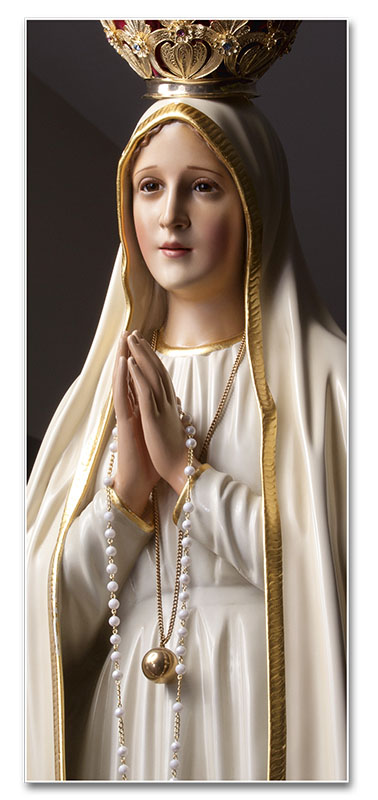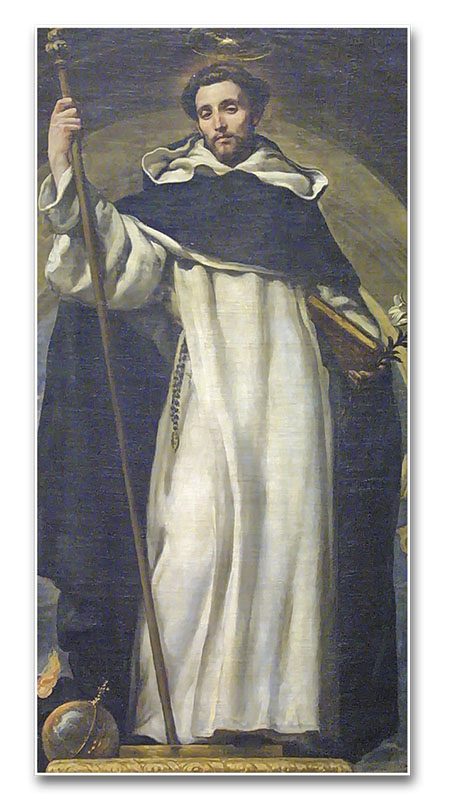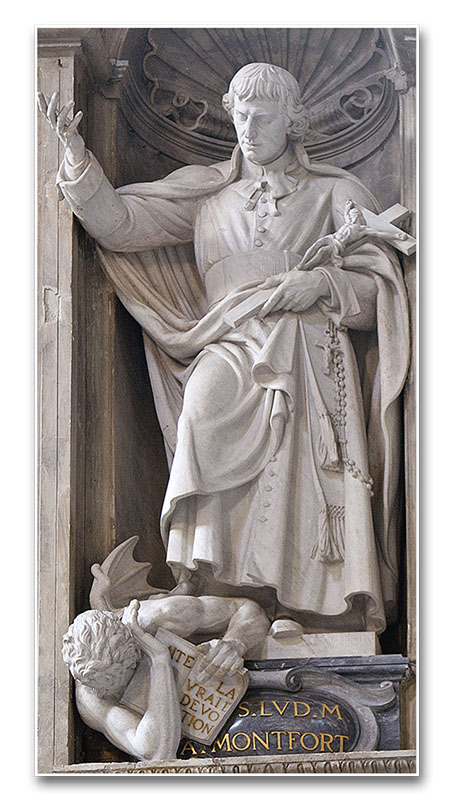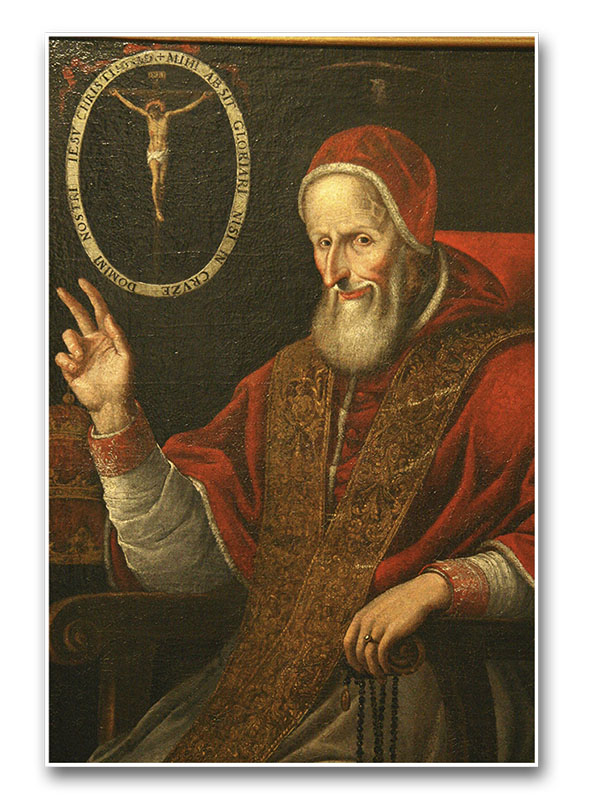In the apparitions of Fatima, Our Lady asked the three shepherd children for the daily recitation of the Holy Rosary. What treasures does this devotion contain that makes it so pleasing to the Blessed Virgin?
In every historical age, especially in times of great crisis, Divine Providence has brought forth souls who act as living oracles to point out the right path to humanity, to admonish it for its evil conduct and to serve as prefigures of the future.
This is what took place with the fall of the Western Roman Empire, illuminated and analysed by St. Augustine, with the decline of the Middle Ages, announced by St. Vincent Ferrer, and with the outbreak of the French Revolution, which closed the Modern Age, foreseen by St. Louis Grignion de Montfort. Our “present days, which seem on the verge of ending with a new crisis, have a greater privilege. Our Lady came to speak to men,”1 in the famous apparitions of Fatima, whose centenary we are celebrating.
In addition to warning about the sins of humanity, the Blessed Virgin announced to the three shepherd children a new era in the history of the Church, described by Msgr. João Scognamiglio Clà Dias as follows: “Fatima points with great clarity to a future triumph and glory, which will take place after the repentance and conversion of humanity. This future will surpass the expectations of the most hopeful, for no one can imagine the apex of sanctity and beauty attainable when the Immaculate Heart of Mary transforms souls and enthrones her Divine Son in them.”2
Fatima and the Holy Rosary

In the six apparitions that took place from May to October 1917, the Blessed Virgin “explains the reasons for the crisis and indicates its solution.”3 And as a very powerful means for obtaining the conversion requested, she highlights devotion to her Immaculate Heart, the Communion of reparation on Five First Saturdays and, above all, recitation of the Holy Rosary.
Our Lady insisted particularly on this last point. In fact, in each of the apparitions She recommended this practice to the young shepherds, but on July 13 She was even more categorical, affirming: “continue to pray the Rosary every day in honour of Our Lady of the Rosary, in order to obtain peace for the world and the end of the war, because only She can help you.”4
And during the last apparition, the “Lady all dressed in white more brilliant than the sun”5 once again counselled daily recitation of the Rosary and described herself with these words: “I am the Lady of the Rosary.”6
What treasures does Mary’s Psalter contain that Our Lady should so repeatedly urge its recitation? Why did She declare that only the Lady of the Rosary can help us obtain peace? Let us delve a little deeper into the significance of this magnificent centuries-old devotion, in order to grasp the treasures that it contains.
Dispenser of all graces
Mary Most Holy is She “through whom God Himself, our King, disposed since the beginning to carry out the salvation of the world.”7
It was not without reason that, from the height of Calvary, the Divine Redeemer wished to give her to humanity as Mother, in the person of the beloved disciple: “When Jesus saw His Mother, and the disciple whom He loved standing near, He said to His Mother, “Woman, behold, your Son!” Then He said to the disciple, “Behold, your Mother!’” (Jn 19:26-27).
Thus, it was based on “her cooperation in the redeeming sacrifice of Jesus Christ, and of her spiritual motherhood over all the redeemed, that Mary acquired the titles of universal Mediatrix and Dispenser of all graces.”8
Since the Wedding of Cana (cf. Jn 2:1-11), at the beginning of Jesus’ public life, and in the earliest times of the nascent Church, when the Apostles gathered with Mary in the Cenacle (cf. Acts 1:14) awaiting the coming of the Paraclete who would give them the strength and courage to fulfil Christ’s mandate to bring “the Gospel to every creature” (Mk 16:15), as well as over the course of history, Our Lady has favoured her children in a variety of ways, granting them efficacious means to obtain from her maternal intercession the graces needed to carry out the mission God gave to each one.
St. Dominic and the Psalter of Mary

One of the key moments of her intervention took place in the thirteenth century, when Christianity was threatened with the terrible heresy of the Albigensians, or Cathars, that raged throughout Europe, despite the efforts made by Popes to contain it. Dominic de Guzman was one of the great defenders of orthodoxy and had been designated to preach in Languedoc, the main hub of the evil, during the fiercest battles against this heresy.
Weighed down with grief at the number of souls that were straying from the right path and seized by an interior motion, he went to a forest near Toulouse to do penance and implore God to take pity on His Church. They were three days and nights of austere sacrifice, lamentation, tears and, above all, prayer.
When his body was at the point of collapse, the Queen of Heaven herself appeared in resplendence, asking if he knew which weapon the Blessed Trinity wished to use to reform the world. He replied that this weapon was She herself, Mary Most Holy. To which She replied: “The principal weapon has always been the Angelic Psalter, which is the foundation-stone of the New Testament. Therefore, if you want to reach these hardened souls and win them over to God, preach my Psalter.”9
From that time forward, St. Dominic began to spread devotion to the Rosary and the Blessed Virgin started shedding abundant graces on those who recited it, obtaining many conversions, a great change in customs and the victory of the Church over the heresy. And the Saint went down in history as the apostle of this devotion which binds Heaven to earth.
There is no more excellent and meritorious devotion

St. Peter’s Basilica, Vatican
In fact, the eminent Marian theologian St. Louis-Marie Grignion de Montfort teaches that “Our Lady’s Psalter or the Rosary made up of the Our Father and Hail Mary is the direct work of the Most Blessed Trinity.”10 And he explains its meaning: “[It] is divided into three chaplets of five decades each, for the following reasons: first, to honour the three persons of the Blessed Trinity; second, to honour the life, death and glory of Jesus Christ; third, to imitate the Church triumphant, to help the members of the Church militant, and to bring relief to the Church suffering; fourth, to imitate the three groups into which the psalms are divided, the first being for the purgative life, the second for the illuminative life, and the third for the unitive life; fifth, to give us graces in abundance during life, peace at death, and glory in eternity.”11
If we examine its Joyful, Sorrowful and Glorious Mysteries, we see that “The Rosary – a compendium of the Gospel – recalls the main episodes of Our Redeemer’s life.”12 “Contemplating the scenes of the Rosary in union with Mary is a means of learning from Her to ‘read’ Christ, to discover His secrets and to understand His message. This school of Mary is all the more effective if we consider that She teaches by obtaining for us in abundance the gifts of the Holy Spirit, even as She offers us the incomparable example of Her own ‘pilgrimage of faith.’”13
By all of this we better comprehend the revelation that the Virgin herself made to Blessed Alan de la Roche: “after the holy sacrifice of the Mass, which is the first and most living memorial of our Lord’s passion, there was indeed no more excellent devotion or one of greater merit than that of the Rosary, which is like a second memorial and representation of the life and passion of Jesus Christ.”14
Splendid means for attaining perfection
St. Louis de Montfort,15 himself an excellent preacher of the Marian Psalter, cites some examples of the Blessed who never abandoned the recitation of the Rosary, finding in it the strength for their virtue: St. Francis de Sales, St. Charles Borromeo, St. Thomas of Villanova, St. Ignatius of Loyola, St. Francis of Borgia, St. Teresa of Jesus and St. Philip Neri among others.
And to further encourage us to follow the path of these exemplary souls, he adds “that the Rosary recited with the meditation of the mysteries brings about the following marvellous results: first, it gradually brings us a perfect knowledge of Jesus Christ; second, it purifies our souls from sin; third, it gives us victory over all our enemies; fourth, it makes the practice of virtue easy; fifth, it sets us on fire with the love of Our Lord; sixth, it enriches us with graces and merits; seventh, it supplies us with what is needed to pay all our debts to God and to our fellow-men, and finally, it obtains all kinds of graces from God.”16
Authors of the spiritual life are unanimous in asserting that meditation on the mysteries of the Rosary is a remarkable means of perfection. And it is a mistake to think that this is a way exclusive to priests or religious.
The same St. Louis de Montfort affirms that “if priests and religious have an obligation to meditate on the great truths of our holy religion in order to live up to their vocation worthily, the same obligation is just as much incumbent on the laity, because of the fact that every day they meet with spiritual dangers which might cause them to lose their souls. Therefore they should arm themselves with the frequent meditation on the life, virtues, and sufferings of our Blessed Lord, which are presented to us in the fifteen mysteries of the holy Rosary.”17
Devotion of the Supreme Pontiffs

Museum of Fine Arts, Salamanca (Spain)
Father Antonio Royo Marín, one of the most renowned Dominican theologians of the past century, states that “without any doubt the Rosary is the most excellent of Marian devotions.”18 And, in following his usual line of clear and progressive reasoning, he adds: “It is proven so by the Virgin herself, the official Magisterium of the Church, and by its structure and theological content.”19
To round out this reflection, it would be fitting to mention the esteem for the holy Rosary of virtually all of the Supreme Pontiffs over the centuries and to recount some of the numerous documents of the Magisterium dedicated to extolling this devotion which is so deeply rooted in the hearts of the faithful, but this would imply extending this article beyond space limitations.
Therefore, we make just brief mention of Pius V, the Pope of the Rosary, who instituted on October 7 the feast of Our Lady of Victory in thanksgiving for the intervention of the Blessed Virgin Mary in the Battle of Lepanto; his successor, Gregory XII, dedicated the same day to Our Lady of the Rosary.
It is also indispensable to recall St. John Paul II and his Encyclical Rosarium Virginis Mariæ, previously cited, by which the fondly remembered Pontiff of “Totus tuus” inaugurated the Year of the Rosary in 2002.
Dawn of the Reign of Mary
In the apparitions of Fatima, Our Lady expressed God’s desire with humble clarity to the shepherd children: “He wants to establish in the world devotion to my Immaculate Heart. I promise salvation to those who embrace it, and those souls will be loved by God like flowers placed by me to adorn His throne.”20 And the holy Rosary is the conditio sine qua non to persevere in this devotion, as She so often repeated.
Thus, heeding the message brought by the Mother of God presupposes that we strive to be, as St. Louis-Marie Grignion de Montfort says, “true servants of the Blessed Virgin who, like a Dominic of old, will range far and wide, with the holy Gospel issuing from their mouths like a bright and burning flame, and the Rosary in their hands, and bay like your watchdogs, burn like fire and dispel the darkness of the world like a sun.”21 If we proceed in this way, we will soon glimpse on the horizon the dawn of the triumph of her Immaculate Heart.
“It was through the Blessed Virgin Mary that Jesus came into the world, and it is also through her that He must reign in the world,”22 St. Louis de Montfort further teaches. In this way, “Her triumph is the triumph of Christ. It is the Reign of Mary, in the Reign of Christ!”23
Let us give ourselves wholly to Our Lady’s aid with the assurance that if we will remain faithful to her and her holy Rosary, we will be witnesses of new wonders and the fulfilment of her prophecy. ◊
Taken from the Heralds of the Gospel Magazine, #120.
1 CORRÊA DE OLIVEIRA, Plinio. Fátima: explicação e remédio da crise contemporânea [Fatima: Explanation and Remedy for the Contemporary Crisis]. In: Catolicismo. Campos dos Goytacazes. Year III. N.29 (May, 1953); p.2.
2 CLÁ DIAS, EP, João Scognamiglio. In the end, my Immaculate Heart will triumph! Nobleton: Heralds of the Gospel, 2017, p.101.
3 CORRÊA DE OLIVEIRA, op. cit., p.2.
4 SISTER LUCIA. Fatima in Lucia’s own words. Fourth Memoir, c.II. Fatima, Portugal: Postulation Centre, 1976, p.161.
5 Idem, p.156.
6 Idem, p.168.
7 ST. BERNARD. In laudibus Virginis Matris. Hom.IV, n.8. In: Obras Completas. 2.ed. Madrid: BAC, 1994, v.II, p.673.
8 CLÁ DIAS, EP, João Scognamiglio. Pequeno Ofício da Imaculada Conceição comentado. 2.ed. São Paulo: ACNSF; Lumen Sapientiæ, 2011, v.II, p.125.
9 ST. LOUIS-MARIE GRIGNION DE MONTFORT. The Secret of the Rosary. Second Rose. In: God Alone. Bayshore, NY: Montfort Publications, 1987, p. 157.
10 Idem, Sixth Rose, p.163.
11 Idem, Sixth Rose, p. 163-164.
12 CLÁ DIAS, EP, João Scognamiglio. Christmas under the Sign of the Rosary. In: New Insights on the Gospels. Nobleton: LEV – Heralds of the Gospel. Volume I, p. 125.
13 ST. JOHN PAUL II. Rosarium Virginis Mariæ, n.14.
14 ST. LOUIS-MARIE GRIGNION DE MONTFORT, op. cit., Twenty-eighth Rose, p.195.
15 Cf. Idem, Twenty-sixth Rose, p.192.
16 Idem, Twenty-seventh Rose, p.192-193.
17 Idem, Twenty-fourth Rose, p.189.
18 ROYO MARÍN, OP, Antonio. La Virgen María. Teología y espiritualidad marianas. 2.ed. Madrid: BAC, 1997, p.460.
19 Idem, ibidem.
20 SISTER LUCIA, op. cit., p.161, 187.
21 ST. LOUIS-MARIE GRIGNION DE MONTFORT. Prayer for Missionaries. In: God Alone, op. cit., p.403.
22 ST. LOUIS-MARIE GRIGNION DE MONTFORT. Treatise of True Devotion to Mary, n.1. In: God Alone, op. cit., p.291.
23 CLÁ DIAS, In the end, my Immaculate Heart will triumph!, op. cit., p.16.
